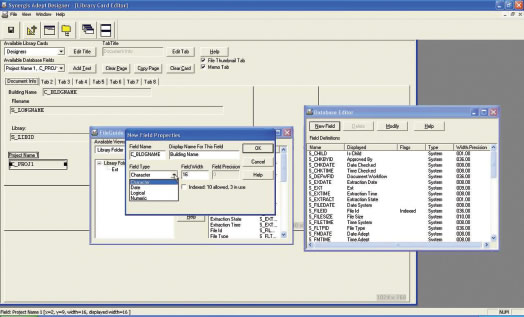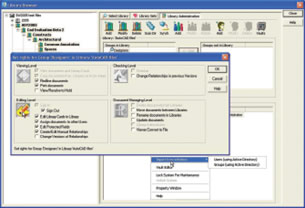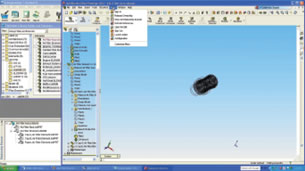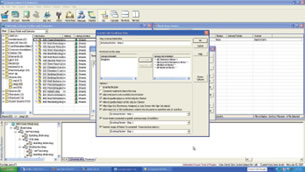Latest News
December 4, 2001
By David Cohn
 Figure 1: The library card is one of the primary ways of viewing data inside Adept, and Synergisprovides a very intuitive Designer application enabling users to create new library cards. |
It’s not often we get a chance to do an in-depth hands-on review of a document and data management solution, the complexity of installation and implementation representing far too high a hurdle. But after visiting with Synergis Software earlier this year, we concluded that the company’s Adept software might be an exception to the rule. Adept provides a single point of control for managing engineering drawings, business documents, and related information via a LAN, WAN, or across the Internet.
 Figure 2:Within Adept’s Library Browser, the Administrator can add users (even importing them fromWindows Active Directory) and then assign rights and permissions to individual users and groups. |
Document management is a basic tool for any organization that wants to centralize, control access, and organize its engineering and business documents and automate engineering change processes. Synergis, which has spent more than 18 years developing its document management software, actually has two divisions: Engineering Design Solutions is an AutoCAD VAR, and Synergis Software develops, implements, and supports the Adept software. Synergis’ initial forays into document management were efforts to solve the specific needs of several of its AutoCAD customers. Today, Adept customers include Caterpillar, General Mills, W.L. GORE and Associates (the makers of Goretex), NASA, and the U.S. Coast Guard. Adept manages all kinds of documents, not just CAD, and it can be used at every level of an organization. Synergis has also helped clients integrate Adept into other software systems, including MRP, ERP, GIS, cost estimating, project management, and general accounting applications, including MAPICS, SAP, and Oracle.
Complex Initial Setup
 Figure 3: Once up and running, Adept makes it easy to locate, check out, and open files associated withany project. SolidWorks users can access Adept directly from within their CAD application. |
The primary goals of Adept are to make data accessible and relevant, find documents quickly and easily, re-use existing design data efficiently, control revisions, and manage complex file relationships. With those goals in mind, we set out to evaluate the latest version of Adept.
Synergis shipped us a two-seat license of the MySQL version of Adept 7. We then met with Chris Fabri, a Synergis Adept applications specialist, via telephone and web-based meeting software, in order to properly install, configure, and learn to use the Adept server and client software.
The first step was to install the MySQL software and then create a new schema and user account with administrator privileges so that we could configure software parameters. We also had to set startup variables for Adept. This was quite an involved process, accomplished only by carefully following Fabri’s instructions; but according to Fabri, while some customers do these initial steps themselves (after first attending training at Synergis’ headquarters), typically someone from Synergis goes to the customer site to help with the installation. Once completed, the customer typically never needs to touch these settings again.
After installing and configuring the database and Adept server software, the first step as an Adept administrator was to use the Adept Designer software component to create a new database and design the first “library card,” the actual database interface screen that individual users would see when interacting with the document management system. Here we were able to select the database fields that we wanted to track. We could add, delete, or modify field names we wanted displayed and graphically design the appearance of the Adept library cards using an intuitive interface. If the database doesn’t include all the fields you want to track, you can add new fields. You can also create different library cards for different groups. For example, some users may want to look at library cards in different ways, or you may want to assign a specific library card to a specific person or group so that they can only see information in a certain way.
We also set up various user accounts and assigned them to the appropriate user groups. For example, engineers on a particular project may need to save new versions of documents while sales personnel only need to be able to view documents — and employees not working on that project don’t need to see them at all.
 Figure 4:Workflows in Adept ensure that each step gets completed properly before a document canmove on in its development process. |
Of course, only administrators have to deal with any of the functions we had to tackle in our initial implementation. Regular users see none of this. They interact only through the Adept client software, which was the final component we installed. The client software is typically the only component that gets installed on individual user’s system. Synergis offers two types of Adept clients: the full-featured Desktop version for people who need to create and modify documents and a thin web-based Explorer client for those who need to access and review documents and information stored in Adept in primarily a read-only mode.
We Test Drive Adept
For our evaluation, we worked with the Adept Desktop client. With this version, users can create, modify, and view documents along with their associated metadata and relationships and have full access to Adept’s CAD integrations. Adept administrators can import documents; add users and groups, and control permissions; and create and modify workflows. Since we’d be working with AutoCAD, Inventor, and SolidWorks files, we installed specific plug-ins so that Adept would know how to deal with these applications.
We then told Adept where on our network to look for files, what information to track, and which files to load into its database. We were now ready to use Adept to manage our documents. There are nearly endless options so that Adept can meet the needs of a wide range of users. The software can track revisions, maintain a history of changes, alert users when disk storage locations are getting full, and extract data from native CAD files so that changes to title blocks and simple spelling errors can be made without having to open the native CAD files. But managing CAD workflows is certainly the product’s forte.
Consider for example an engineer working on a SolidWorks assembly. The engineer would use the Adept Desktop client software to locate the assembly within the project’s folder, sign out the assembly, and then launch SolidWorks. Any attempt to open the assembly or a part file from within SolidWorks automatically opens the Adept client, showing a list of the files that have been checked out. After selecting the desired file, Adept automatically opens the file in SolidWorks. When the engineer is finished working on the files, he can sign them back in directly from within SolidWorks. The files remain in his work area, however, until he releases ownership, at which time they are checked back in as a new version. New to Adept 7 is the ability to support SolidWorks configurations, reducing the number of files that users need to manage.
The Adept administrator can also set up various workflows and then assign a specific workflow to any Adept library. Once established, a workflow determines how and to whom documents get routed as they move through various development steps. For example, you can require an engineer to open a drawing file to put his digital signature into the file before continuing on in the workflow process, or force the document into another step in the workflow (for example, always go back to step 3 if a document is rejected). Again, workflow capabilities are considerably enhanced in the new release with the ability to add automatic e-mail notification upon completion of a workflow, display a list of approvers for a specific step, and see the name of a given library’s default workflow as well as a list of the groups in each workflow step. Administrators can also now view a workflow report after each change to a workflow in order to ensure that the workflow is set up c orrectly for a given library.
Adept also includes a viewer that displays more than 300 file formats — including AutoCAD DWG, DXF, and DWF files as well as 3D models from Inventor and SolidWorks — so users can view, add redline comments, and print hard copies of any viewable document without needing to install the native application on their workstation.
For companies just getting started with Adept, the software offers powerful import commands that enable customers to set up their libraries based on existing directories, even if they are nested. The software then scans all the folders you want to import and creates a one-to-one relationship between each file on the server and its corresponding Adept database record. At the same time, the batch import mechanism extracts file properties from Inventor, SolidWorks, Microsoft Office files, and attributes from AutoCAD drawing files. Adept also analyzes Autodesk and SolidWorks files and determines the relationship of the file to externally referenced files. This relationship information is automatically stored in the database and is available for managing relationships among supported files.
Synergis also makes it relatively easy to establish Adept user accounts. The administrator can set up groups manually, but Adept 7 can also now import and update user names and group information from the Windows Active Directory. Once user names and groups are imported, the Adept administrator can easily assign user and group permissions to Adept libraries.
According to Synergis, Adept 7 also delivers enhanced performance for the most common daily activities of engineering and design users, including searching, sorting, and the display of information. Based on the company’s own testing, Adept 7 searches through a database of 500,000 records 53 percent faster than Adept 6.
Our evaluation wasn’t entirely trouble free, and we would anticipate that most users might experience a similar “break-in” period. At present, Adept works well with title blocks based on AutoCAD attributes, but does not yet handle fields, something Synergis is currently working to implement. We also had some problems writing data we had changed in an Adept library card back into AutoCAD, something that should have worked if things were configured properly.
Adept 7 Prices: Desktop version concurrent license: $1,600 plus annual maintenance (for above): $425 MySQL Pro database software: Explorer client: plus annual maintenance (for above): $225 Training, Implementation, PrintWave Publishing and Printing, database extensions, and other services are additional costs to the concurrent licenses listed above. |
Although promoted as largely a shrink-wrapped solution, most customers either hire someone from Synergis to do the initial setup and some on-site training or else send an administrator to attend training and then have someone from Synergis available to monitor the initial roll-out. Still, implementation is relatively straightforward compared to other competitive solutions, with typical implementations up and running within a few weeks. Pricing is also clearly spelled out on the Synergis website, including initial costs and annual maintenance for the various components, including PrintWave, an add-on that enables single- or batch-mode printing, plotting, and PDF publishing directly from within Adept without the need for native CAD applications.
Adept 7 requires an SQL database engine (MySQL, Oracle, or Microsoft SQL Server), and the hardware requirements vary depending on the database chosen. Minimum requirements for individual client workstations are quite modest, however. Detailed information is available on the Synergis website.
Document management needs vary widely from company to company, making a thoroughly qualitative analysis of an application like Adept difficult at best. But judging from our admittedly brief experience, plus the feedback from many satisfied customers, Synergis Adept certainly deserves serious consideration.
More Information
Synergis Software
Quakertown, PA
synergis-adept.com
Contributing Editor David Cohn is a computer consultant and technical writer based in Bellingham, WA, and has been benchmarking PCs since 1984. He’s an applications engineer with The PPI Group, and the author of more than a dozen books. Please send comments about this article to [email protected]. You can also contact David at [email protected].
Subscribe to our FREE magazine, FREE email newsletters or both!
Latest News
About the Author
David Cohn is a consultant and technical writer based in Bellingham, WA, and has been benchmarking PCs since 1984. He is a Contributing Editor to Digital Engineering, the former senior content manager at 4D Technologies, and the author of more than a dozen books. Email at [email protected] or visit his website at www.dscohn.com.
Follow DE





